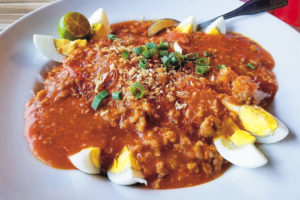Mag Pancit Muna Tayo
Liza of “A Maui Blog”
Pancit is one of the most popular Filipino dishes not only on Maui but in many parts of the USA and the world where Filipino communities thrive. This dish is among the annual favorites at the Maui County Fair, the annual Barrio Fiesta and at the upcoming Maui Fil-Am Heritage Festival® in October. Barrio Fiesta has an annual pancit eating contest and I actually joined the contest this year. I did not win but I was happy to participate because I got to eat the yummy pancit.
Do you know that there are many varieties of pancit? Yes? What is your favorite? Let’s talk story about the different kinds of pancit:

1. Pancit Canton – This is probably the most common or most popular kind of pancit. The noodles are thicker, made of wheat. The noodles are stir-fried with various vegetables such as carrots, cabbage and string beans. Seafood such as squid, shelled shrimp, and meat such as sliced pork and chicken are added. Flavored with soy sauce. This kind of pancit is also sold during Maui County fairs although with less meat or seafood; mostly noodles.
2. Pancit Bihon (also known as Bihon Guisado) – Another popular pancit noodle dish, this type uses bihon or thin rice noodles. The way it is cooked is similar to Pancit Canton. Vegetables, meat (shredded chicken, chopped pork) and/or seafood are sautéed (that’s where the term “Guisado” is. “Guisa” means saute in Tagalog) and soy sauce, pepper are added. Best to eat with some calamansi juice squeezed on it.
3. Pancit Sotanghon – Similar to Bihon Guisado with a different kind of noodle. The noodles are translucent sotanghon (mung bean or glass noodles) also sautéed with a savory sauce, and some hefty toppings. Here on Maui, this kind of pancit, pancit sotanghon, is not popular. Mung Bean Noodles are usually cooked into a soup called “chicken long rice” instead of serving it as pancit.
4. Pancit Lulug – Also referred to in some circles as Pancit Malabon, this dish uses thick rice noodles that are dunked in hot water to soften them prior to adding the lip-smacking, unctuous orange sauce (“Luglog” means “to dunk in water”). Littered with fresh shrimp, squid, and even shucked oysters fresh off the northern fishing town of Malabon, this pancit is legendary and is a known staple in office and classroom parties in the Philippines. I have been looking for a place to buy Pancit Luglug here on Maui but so far I have not found one yet. Do you know where we can buy Pancit Lulug on Maui?

5. Pancit Palabok – This is similar to Pancit Malabon but it uses finer noodles. This can be found on many Filipino restaurants and eateries here on Maui. And with the coming of Jollibee here on Maui, Pancit Palabok will even be more accessible. Pancit Palabok is a noodle dish with shrimp sauce and topped with several ingredients such as cooked shrimp, boiled pork, crushed chicharon, tinapa flakes, fried tofu, scallions, and fried garlic and boiled egg.
Now that we have talked about the various kinds of pancit, I think it’s time to head to one of the Filipino restaurants and try them out. Let’s go!
 Liza Pierce of A Maui Blog is an Interactive Media Strategist in Hawai‘i. She started blogging in 2006 and she loves talking story online and spreading aloha around the world. She’s been living on Maui since 1994 and considers Maui her home. A wife, a mother, a friend…and so much more. She loves Jesus; Maui Sunsets Catcher; Crazy About Rainbow; End Alzheimer’s Advocate. Her life is full and exciting here on the island of Maui. Liza is currently the Interactive Media Strategist with Wailea Realty Corp.
Liza Pierce of A Maui Blog is an Interactive Media Strategist in Hawai‘i. She started blogging in 2006 and she loves talking story online and spreading aloha around the world. She’s been living on Maui since 1994 and considers Maui her home. A wife, a mother, a friend…and so much more. She loves Jesus; Maui Sunsets Catcher; Crazy About Rainbow; End Alzheimer’s Advocate. Her life is full and exciting here on the island of Maui. Liza is currently the Interactive Media Strategist with Wailea Realty Corp.

